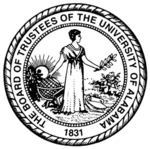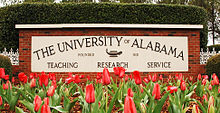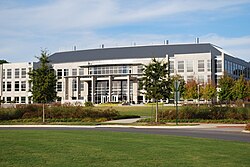
The University of Alabama is a public research university in Tuscaloosa, Alabama. Established in 1820 and opened to students in 1831, the University of Alabama is the oldest and largest of the public universities in Alabama as well as the University of Alabama System. It is classified among "R1: Doctoral Universities – Very high research activity".

Bryant–Denny Stadium is an outdoor stadium in the southeastern United States, on the campus of the University of Alabama in Tuscaloosa. It is the home field of the Alabama Crimson Tide football team of the Southeastern Conference (SEC).

The University of Alabama at Birmingham (UAB) is a public research university in Birmingham, Alabama. Founded in 1969 in the University of Alabama System, UAB has grown to be the state's largest employer, with more than 24,200 faculty and staff and over 53,000 jobs at the university. The university is classified among "R1: Doctoral Universities – Very high research activity".

Lawrence James DeLucas is an American biochemist who flew aboard NASA Space Shuttle mission STS-50 as a Payload Specialist. He was born on July 11, 1950, in Syracuse, New York, and is currently married with three children. His recreational interests include basketball, scuba diving, bowling, model airplanes, astronomy and reading.

The University of Alabama in Huntsville (UAH) is a public research university in Huntsville, Alabama. The university is accredited by the Southern Association of Colleges and Schools and comprises eight colleges: arts, humanities & social sciences; business; education; engineering; honors; nursing; science; and graduate. The university's enrollment is approximately 10,000. It is part of the University of Alabama System and is classified among "R1: Doctoral Universities: Very High Research Activity".
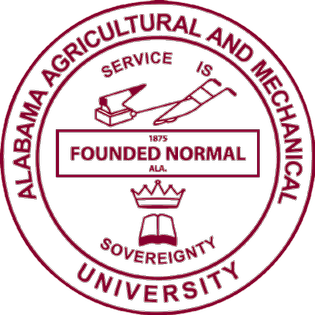
Alabama Agricultural and Mechanical University is a public historically black land-grant university in Normal, Huntsville, Alabama. Founded in 1875, it took its present name in 1969. It was one of about 180 "normal schools" founded by state governments in the 19th century to train teachers for the rapidly growing public common schools. It was one of 23 established to train African Americans to teach in segregated schools. Some closed but most steadily expanded their role and became state colleges in the early 20th century and state universities in the late 20th century. AAMU is a member-school of the Thurgood Marshall College Fund and is accredited by the Southern Association of Colleges and Schools. Alabama Agricultural and Mechanical University Historic District, also known as Normal Hill College Historic District, has 28 buildings and four structures listed in the United States National Register of Historic Places.

UAB Hospital is a 1,295 bed tertiary hospital and academic health science center located in Birmingham, Alabama. It serves as the only ACS verified Level I Trauma Center in Alabama, and is the flagship property of the UAB Health System which is owned by the University of Alabama System. The system includes clinics, an eye hospital and affiliations with other health care facilities throughout the state. It is Birmingham's largest employer, with a staff of over 20,000.

The University of Alabama at Birmingham Marnix E. Heersink School of Medicine is a public medical school located in Birmingham, Alabama, United States with branch campuses in Huntsville, Montgomery, and at the University of Alabama College of Community Health Sciences in Tuscaloosa. Residency programs are also located in Selma, Huntsville, and Montgomery. It is part of the University of Alabama at Birmingham (UAB).

The UAB Blazers are the varsity intercollegiate athletic programs that represent the University of Alabama at Birmingham (UAB). The school is one of the fourteen member institutions of the American Athletic Conference and participates in Division I of the NCAA. The school's men's basketball team plays in 8,508-seat Bartow Arena. The Blazers' colors are forest green and old gold. The men's basketball program has a long history of success spanning several decades.
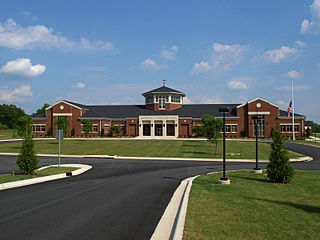
St. John Paul II Catholic High School is a coed grades 9-12 college preparatory school, located in Huntsville, Alabama. St. John Paul II Catholic High School is the only Catholic parochial high school in the greater Huntsville area. It was founded in 1996 on 4810 Bradford Drive, previously known as Catholic High School. A new 55-acre (220,000 m2) campus was completed in late 2010 in Thornton Research Park. The new campus includes a chapel, academic wings, auditorium, gymnasium, and athletic fields.
The 1896 Alabama Crimson White football team represented the University of Alabama in the 1896 Southern Intercollegiate Athletic Association football season. The team was led by head coach Otto Wagonhurst, in his first season, and played their home games at The Quad in Tuscaloosa, Alabama. In what was the fifth season of Alabama football, the team finished with a record of two wins and one loss.
The 1897 Alabama Crimson White football team represented the University of Alabama in the 1897 Southern Intercollegiate Athletic Association football season. The team was led by head coach Allen McCants, in his first season, and played their home games at The Quad in Tuscaloosa, Alabama. In what was the sixth season of Alabama football, the team finished with a record of one win and zero losses.

The CrimsonRide is an area bus service serving the students, staff, faculty, and general public on and around the University of Alabama's campus in Tuscaloosa, Alabama. The CrimsonRide is operated by First Transit, under contract with UA's Department of Transportation Services, and commenced operation on August 11, 2007. The CrimsonRide replaced the previous Blue & Yellow Routes operated by the Tuscaloosa Transit Authority as the public transit option for students, staff, faculty, and general public on the UA campus.

The state of Alabama has invested in aerospace, education, health care, banking, and various heavy industries, including automobile manufacturing, mineral extraction, steel production and fabrication. By 2006, crop and animal production in Alabama was valued at $1.5 billion. In contrast to the primarily agricultural economy of the previous century, this was only about 1% of the state's gross domestic product. The number of private farms has declined at a steady rate since the 1960s, as land has been sold to developers, timber companies, and large farming conglomerates.

Brasfield & Gorrie, LLC, headquartered in Birmingham, Alabama, is one of the United States' largest privately held construction firms, providing general contracting, design-build, and construction management services for a wide variety of markets. Founded in 1964, Brasfield & Gorrie has 12 offices and approximately 3,500 employees. Its 2022 revenues were $5 billion. Engineering News-Record ranks Brasfield & Gorrie 21st among the nation’s “Top 400 Contractors” for 2022. Modern Healthcare ranks the company No. 1 among healthcare general contractors in the nation.
Eli Capilouto is an American academic. He serves as the 12th president of the University of Kentucky. He was elected president by the University of Kentucky Board of Trustees in 2011, after serving as provost of the University of Alabama at Birmingham (UAB). Under his leadership, the Commonwealth's flagship and land-grant research university has grown from $2.7 billion to $6.8 billion in total operations and has gained significant momentum in fulfilling its multi-faceted mission of teaching, research, service and health care.

Ray Lannom Watts is an American physician-researcher in neurology, educator and university administrator. Watts has served as the seventh president of the University of Alabama at Birmingham (UAB) since February 2013.
Paul William Bryant Jr. is an American banker, investor and philanthropist from Alabama.
Joseph F. Volker, (1913–1989) was the first chief executive of the University of Alabama at Birmingham, serving in that capacity from 1966 to 1976. Afterwards, he was the first Chancellor of the UA System, from 1976 to 1982.
